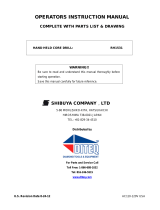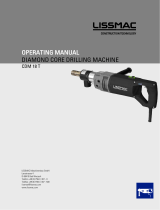English 5
▶Do not touch rotating parts. Switch the power tool on only after it is in position at the workpiece.
Touching rotating parts, especially rotating accessory tools, can result in injury.
▶Avoid skin contact with drilling slurry.
▶Dust from materials such as lead-based paint, certain types of wood and concrete/masonry/stone
containing quartz, minerals or metal can be harmful to health. Contact with or inhalation of the dust can
cause allergic reactions and/or respiratory or other diseases among operators or bystanders. Certain
kinds of dust such as oakwood and beechwood dust are classified as carcinogenic, especially in
conjunction with additives for wood conditioning (chromate, wood preservative). Only specialists are
permitted to handle material containing asbestos. Use as effective a dust removal system as possible.
To achieve a high level of dust collection, use a suitable vacuum extractor of the type recommended
by Hilti for wood dust and/or mineral dust and which is designed for use with this power tool. Ensure
that the workplace is well ventilated. It is advisable to wear a respirator appropriate for the type of dust
generated. Comply with national regulations applicable to the materials you will be working with.
▶The diamond core drilling machine and the diamond core bit are heavy. There is a risk of crushing parts
of the body. The user and persons in the vicinity must wear suitable protective goggles, a hard hat,
ear defenders, protective gloves and protective footwear while the tool is in use.
Power tool use and care
▶Make sure that the device is correctly secured to the drill stand.
▶Always make sure that an end stop is installed on the drill stand as otherwise the safety-relevant
end-stop function is not implemented.
▶Check that accessory tools are compatible with the power tool’s chuck/drive system and that they
are installed and secured correctly.
Electrical safety
▶Do not use extension cords with multiple power outlets powering two or more devices in operation
at the same time.
▶Operate the device only when it is connected to an adequately rated power supply with a ground
conductor.
▶Before beginning work, check the working area (e.g. using a metal detector) to ensure that no
concealed electric cables or gas and water pipes are present. External metal parts on the power tool
can become live, for example if you inadvertently damage electric wiring. This presents a serious risk of
electric shock.
▶Make sure that the supply cord cannot be damaged as the carriage advances.
▶Never operate the machine without the accompanying PRCD (machines without PRCD: Never
operate the machine without an isolating transformer). Test the PRCD each time before use.
▶Check the machine’s supply cord at regular intervals and have it replaced by a qualified specialist if
found to be damaged. If the machine’s supply cord is damaged it must be replaced with a specially
prepared and approved supply cord available from Hilti Customer Service. Check extension cords
at regular intervals and replace them if found to be damaged. Do not touch the supply cord or
extension cord if it is damaged while you are working. Disconnect the supply cord plug from the
power outlet. Damaged supply cords and extension cords present a risk of electric shock.
▶Never operate the machine when it is dirty or wet. Dust, especially dust from conductive materials, or
dampness on the surface of the power tool can, under unfavorable conditions, lead to electric shock.
Have dirtied or dusty machines checked at regular intervals by Hilti Service, especially if they are used
frequently for working on conductive materials.
Workplace
▶Approval must be obtained from the site engineer or site management before beginning work.
Drilling work on buildings and other structures can influence the statics, especially when steel reinforcing
bars and load-bearing components are cut through.
▶If the drill stand has not been secured correctly, always move the machine on the drill stand all the
way down to keep the stand from toppling.
▶Keep the supply cord, extension cord, water hose and vacuum hose away from rotating parts.
▶Use of the water collection system in combination with a wet-type industrial vacuum extractor is
mandatory for upward wet drilling.
▶Use of the vacuum fastening method for upward drilling without additional means of securing the
equipment is prohibited.
▶An additional means of securing the drill stand must be employed when the machine is used for
horizontal drilling with the vacuum securing method (accessory).
Printed: 02.11.2017 | Doc-Nr: PUB / 5145267 / 000 / 04



























